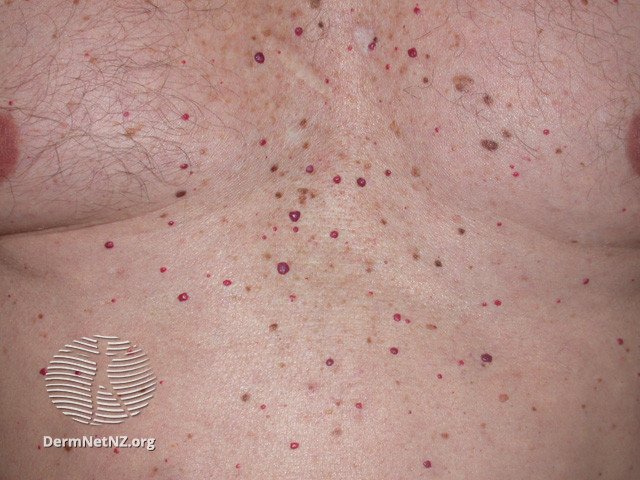
Angiomas (Hemangiomas)
Cherry angiomas, which look like red or purple raised or flat papules on the skin.
Credit: DermNet NZ
What is an angioma?
An angioma is a benign vascular lesion that can manifest on the skin or other organs. This article focuses on skin angiomas. Originating from abnormal growth of cells that constitute blood or lymphatic vessels, angiomas are common in both men and women across all age groups. Generally harmless, some angiomas can occasionally be indicators of underlying liver disease. Types include cherry angiomas, infantile hemangiomas, and cavernous hemangiomas, which primarily occur in internal organs. Pyogenic granulomas and port wine stains, while similar, are considered distinct entities and are discussed separately.
What causes angiomas?
The etiology of angiomas remains largely unclear. Cherry angiomas are thought to arise from mutations in growth factors of cells comprising small blood vessels in the skin. They are more prevalent with advancing age and may have a hereditary component. Infantile hemangiomas are believed to be influenced by poor tissue oxygenation and a higher presence of certain stem cells, particularly in low birth weight infants.
What are the symptoms of angiomas?
Symptoms vary depending on the type of angioma:
Cherry Angiomas: These are red, blue, or purple and can manifest as either raised bumps or flat lesions. Ranging in size from 0.1–1 cm, they start off flat and may protrude as they grow. They can occasionally turn black if injured and are most commonly found on the scalp, face, lips, and trunk.
Infantile Hemangiomas: These appear as red or blue raised lesions, usually surfacing before the child is 4 weeks old. They can grow until around 5 months of age and typically shrink thereafter, often leaving permanent skin discoloration. They may also cause pain, bleeding, and disfigurement, and can sometimes be linked to underlying heart, eye, respiratory, or vascular issues. Severe cases may necessitate referral to a pediatric dermatologist or plastic surgeon.
How do I treat angiomas?
Treatment options depend on the angioma's type, size, and location. While treatment is often not medically necessary, individuals may opt for it for cosmetic reasons or to address symptoms like pain or bleeding.
Cherry Angiomas: Treatment methods include electrosurgery, laser therapy, and cryotherapy.
Infantile Hemangiomas: Treatment options consist of oral propranolol, topical beta-blockers like timolol, potent topical or oral steroids, topical antiseptics if infection is suspected, and laser therapy.
Cherry angiomas can sometimes appear dark purple or black which can make them easy to mistake for skin cancer.
Credit: DermNet NZ


